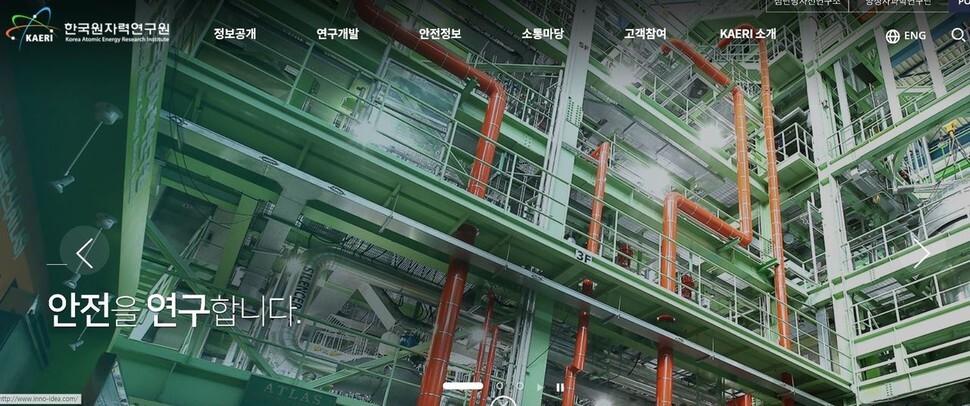hankyoreh
Links to other country sites 다른 나라 사이트 링크
Leak of radioactive material at atomic energy research institute attributed to mismanagement

A leak of radioactive material discovered in stream soil within the Korea Atomic Energy Research Institute (KAERI) in Daejeon early last month has been attributed to a combination of mismanagement -- including lax operation of facilities -- and design issues with the facilities involved in the leak. With design issues only now discovered well over 30 years after the natural evaporation facilities in question were built in 1982, the institute appears likely to face criticism for mismanagement.
At its 114th meeting on Jan. 31, the Nuclear Safety and Security Commission (NSSC) received a report from the secretariat on findings from an interim investigation launched on Jan. 21 into the leakage of radioactive materials at KAERI. On Jan. 22, the NSSC announced that an incident had taken place in which artificial radioactive radionuclide materials leaked from natural evaporation facilities at KAERI, including cesium-137, cesium-134, and cobalt-60. The natural evaporation facilities are used to evaporate extremely low-level radioactive liquid waste (185 becquerels per liter and under) from the institute to filter the sludge.
The Nuclear Safety and Security Commission (NSSC) blamed the facility operator’s inexperience for a leak of contaminated water that was supposed to evaporate inside the facility. When a faulty filter prevented the water from flowing properly, the operator set the valve on max to increase the water volume instead of immediately replacing the filter. The valve was left at that setting even after the filter was replaced, causing the water to overflow and leak into the machine room.
The operator then poured that water down the drain in the service room, sending it flowing into the storm drain outside the facility. The operator had mistakenly believed that the service room drain was connected to the contaminated water storage tank in the basement. This operator has reportedly been working at the facility since last year. Another factor in the incident were design flaws that allowed water from the collection channel to spill into the machine room and that connected the building’s pipes directly to the storm drain outside.
Investigators also learned that around 50 liters of contaminated water has leaked every time the institute replaces the filter on its natural evaporation facility. Assuming that the filter has been changed 13 times altogether, at an interval of two or so years for the past 30 years, a total of 650 liters of contaminated water has leaked.
After receiving the final report in March, the NSSC plans to hold another discussion about what administrative measures or other disciplinary action should be taken against the responsible parties and what should be done to prevent a recurrence.
By Kim Eun-hyoung, staff reporter
Please direct comments or questions to [english@hani.co.kr]

Editorial・opinion
![[Column] Season 2 of special prosecutor probe may be coming to Korea soon [Column] Season 2 of special prosecutor probe may be coming to Korea soon](https://flexible.img.hani.co.kr/flexible/normal/500/300/imgdb/original/2024/0426/3317141030699447.jpg) [Column] Season 2 of special prosecutor probe may be coming to Korea soon
[Column] Season 2 of special prosecutor probe may be coming to Korea soon![[Column] Park Geun-hye déjà vu in Yoon Suk-yeol [Column] Park Geun-hye déjà vu in Yoon Suk-yeol](https://flexible.img.hani.co.kr/flexible/normal/500/300/imgdb/original/2024/0424/651713945113788.jpg) [Column] Park Geun-hye déjà vu in Yoon Suk-yeol
[Column] Park Geun-hye déjà vu in Yoon Suk-yeol- [Editorial] New weight of N. Korea’s nuclear threats makes dialogue all the more urgent
- [Guest essay] The real reason Korea’s new right wants to dub Rhee a founding father
- [Column] ‘Choson’: Is it time we start referring to N. Korea in its own terms?
- [Editorial] Japan’s rewriting of history with Korea has gone too far
- [Column] The president’s questionable capacity for dialogue
- [Column] Are chaebol firms just pizza pies for families to divvy up as they please?
- [Column] Has Korea, too, crossed the Rubicon on China?
- [Correspondent’s column] In Japan’s alliance with US, echoes of its past alliances with UK
Most viewed articles
- 1Is Japan about to snatch control of Line messenger from Korea’s Naver?
- 2‘We must say no’: Seoul defense chief on Korean, USFK involvement in hypothetical Taiwan crisis
- 3[News analysis] Using lure of fame, K-entertainment agency bigwigs sexually prey on young trainees
- 4Will NewJeans end up collateral damage in internal feud at K-pop juggernaut Hybe?
- 5‘Weddingflation’ breaks the bank for Korean couples-to-be
- 6Division commander ordered troops to enter raging flood waters before Marine died, survivor says
- 7No good, very bad game for Korea puts it out of Olympics for first time since 1988
- 8“Korea is so screwed!”: The statistic making foreign scholars’ heads spin
- 9The dream K-drama boyfriend stealing hearts and screens in Japan
- 10[Column] The clock is ticking for Korea’s first lady